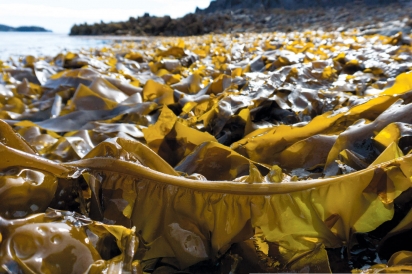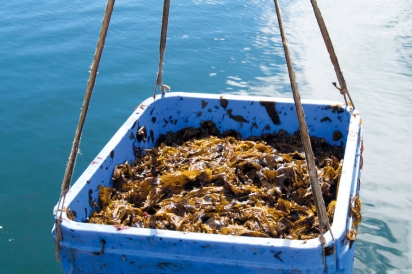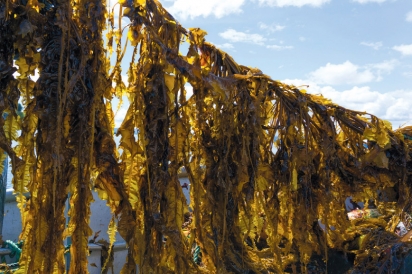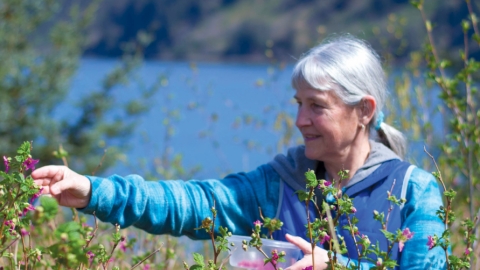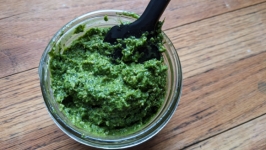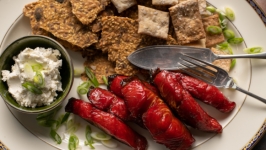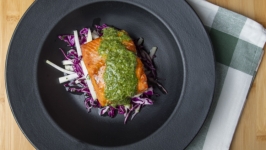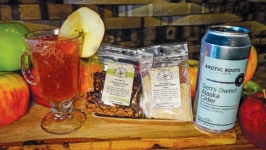Kodiak Kelp
Fisher-farmers set a future for Alaska’s blue-green economy
At first glance, the kelp farm appeared as an unassuming collection of buoys, corks, and floats scattered over a stretch of water. Yet beneath the surface, this grid of gear suspended a treasure trove of ribbon kelp, Alaria marginata, and sugar kelp, Saccharina latissima.
“The ideal growing conditions are around seven feet down so the weights and corks hold the line lower in the water at the depth kelp grows best,” explained Alf Pryor as he maneuvered the open skiff into position. He hauled an Alaria-laden line onto a roller at the bow and ran the line out to a block at the stern. As he pulled the skiff along the line, glistening ribbons of golden-brown kelp emerged from the water like thick tresses of a gigantic mermaid.
Early last summer, I joined Pryor and his friend Brian Large on the last harvest day of the season. Crunch, crunch. Juicy knife bites separated the kelp’s stipe from the blade. Stipes, resembling a plant stem, stayed on the line. Blades, similar to a plant leaf, sailed into fish totes. Kelp fragments and saltwater droplets scattered in all directions, filling the air with the briny smell of the sea. Despite the brilliant sun, we all wore rain gear, rubber gloves, and bits of kelp on our faces. “It’s not that glamorous being a kelp farmer,” Pryor said with a laugh.
Pryor is a lifelong Kodiak set net fisherman, artist, entrepreneur, and dedicated kelp farmer. He began farming kelp in 2016, helping Nick Mangini, who held one of the first seaweed farming permits in Alaska. The site started out as a one-acre plot in the winter of 2016-17 with 3,000 feet of seed line. The following year, Mangini put Pryor in charge of the site, which had scaled up to 36,000 feet of seeded line. At almost 17 acres, Pryor unexpectedly found himself managing North America’s largest seaweed farm.
A reserved deep thinker, Pryor devotes his full focus and energy to what he does. His voice perked up when he spoke about the project. “The kelp farming fits really well with my background from set netting,” he said. “This kind of work with lines, anchors, building sets… it’s what I’ve been doing for decades. We’ve been fishing for so long that we have our systems down,” he added. “With kelp, it’s pretty exciting because things are changing fast all the time. That’s what’s really hooked me on it. It’s a big challenge.”
On the skiff, Pryor and Large worked steadily, keeping the line cranking and the kelp flying. The two have been lifelong friends. They grew up together up in Kodiak, and have been set net fishermen since they were ten years old. Now with families of their own, they navigate the uncharted waters of Alaska’s nascent seaweed farming future, setting the stage for the next generation of fisher-farmers in Kodiak. “Alf helped me with the application process,” said Large, who is waiting on his permit, which can take six to 12 months to receive. In the meantime, he has been learning the ropes by helping Pryor with harvests, just as Pryor had helped Mangini the year before.
“It’s pretty funny because as fishermen, we don’t like kelp, especially bull kelp. It gets caught in our gear and can mess up your motor,” said Large. “Now, we’re growing it.” Large is slim and outgoing, with a cheerful mellow voice. “I love dulse,” he quickly added, referring to Palmaria spp., a reddish seaweed. “You can flash-fry it in peanut oil. Dip it in for a second. It turns green and has got that crispness to it. Use it for sesame seed popcorn chips every movie night.” Although there are no dulse farms currently in Alaska, there is potential for farming it, along with a variety of other seaweeds that naturally grow along Alaska’s 47,300 miles of tidal shoreline.
The connection between kelp farming and fishing is multifaceted and synergistic. “The timing is really good,” affirmed Pryor. “You can set stuff up in the winter and have a spring harvest before the salmon arrive, then go fishing for three months. You’re also in really good shape when the fishing season begins because harvesting kelp is pretty physically demanding.”
Kelp farming also up-cycles older fishing gear. Most of Pryor’s set designs incorporate salvaged corks, lines, and anchors. “It’s one of Kodiak’s resources —old fishing gear. There’s mountains of gear in old-time fishermen’s yards.” Salvaging old gear can save a kelp fisherman thousands of dollars, and also seems to work better. “Brand new lines are almost waxy,” observed Pryor. “Old line is way better because it’s already roughed up and softer, so the kelp can grab it, stick to it.” After filling the totes, we delivered them to the fish processor where a crane lifted the kelp out of the boat and onto the loading dock.
Growing opportunity
Interest in aquatic plant farming has bloomed in Alaska as a way to produce food without chemicals and to mitigate the impact of climate change through carbon sequestration. The economic promise for growing seaweed in Alaska’s pristine waters is enticing, especially with global demand exceeding wild supply. According to the United Nations Food and Agriculture Organization, ocean farming of food produced more than 96 percent of the world’s supply of seaweed products, valued at $5.6 billion in 2016. That year, the Alaska Mariculture Task Force formed to create a plan and recommendations for “a viable and sustainable mariculture industry producing shellfish and aquatic plants for the long-term benefit of Alaska’s economy, environment, and communities,” according to their website. Permits are issued through a joint-agency program administered by the Alaska Department of Fish and Game and the Department of Natural Resources.
Because not enough is understood about the life cycle and ecology of Alaskan kelp and the potential impacts of farming, permits aim to protect existing genetic variability of natural populations and marine ecosystems. All kelp farmed in Alaska is required to be grown from local spores collected from wild kelp growing within 50 kilometers of a farm site. As a result, Alaska’s kelp farms function as man-made extensions of the original kelp beds to produce food that is truly local to its place.
Unlike farmers who grow vegetables on land, Kodiak’s ocean farmers begin their season in the middle of winter, setting up the gear and then the long lines. They purchase seed from a commercial hatchery at the National Oceanic and Atmospheric Administration lab on Near Island. The hatchery is run by Blue Evolution, a California seaweed company.
For the past four years, Tamsen Peeples was Blue Evolution’s Alaska Mariculture Manager. Born and raised in Juneau, Peeples came to Blue Evolution with a degree in marine biology and a passion for Alaska’s coastal environment. The energetic kelp queen built and ran the commercial aquatic plant hatchery to produce seeded lines for farmers, including Pryor. She collected fertile kelp fronds in the fall near farm sites and cultivated spores on seed strings in incubation tanks. When the kelp seeds were ready for outplanting, the farmers used PVC pipes to wind the seeded lines around the long lines. “Those first weeks after outplanting are pretty terrifying,” confessed Peeples. “It grows so slowly at first, you’re not sure if it worked or not. A few weeks later, it goes bonkers, and then you’re like, yay!” By harvest time in late spring, Alaria can grow more than 12 feet.
Blue Evolution is also the only company that purchases Kodiak kelp, which is processed at a local fish processer and then sent to restaurants in the lower 48 and partners for consumer testing. Peeples helped with the harvest and monitored quality control, and she also worked on product development at the Kodiak Seafood and Marine Science Center testing optimal processing methods such as freezing, blanching, drying, and even smoking the kelp in a fish smoker. The company is open to working with Kodiak restaurants, and even collaborated with the Kodiak Island Brewing Company to create the kelp-based “Sea Level Gose,” a 2018 limited-edition sour.
From struggle to success
Like land farming, kelp farming requires hard work, dedication, and persistence for a good part of the winter and spring. Pryor’s 2017-18 season was wrought with challenges. Permitting delays resulted in late outplanting at the end of January, shortening the harvest season. “Right after I finished setting up the farm, we had one of the biggest storms ever, 100 or so mile-an-hour winds,” recalled Pryor. Depending on when the storms occur during the growing season, farmers risk losing their crop because the large surface area of kelp makes the lines more vulnerable to being dragged around by the tides and the wind.
The massive scaled-up size of the farm introduced more complexity. The lines started out in a grid pattern but did not stay put. “It’s hard to keep the lines separated,” said Pryor. “I remember getting a text at night that a giant spruce tree had hit it and collapsed one side of the farm, so I had to race out here and fix it.” Throughout the growing season, Pryor diligently checked on his crop at least once a week until harvest.
“Farming is a different mindset than fishing,” mused Peeples. “You have to tend to your crop.” Despite all the hardships of the 2018 season, the site ultimately produced an astounding 45,000 pounds of seaweed. “That’s all due to Alf’s hard work,” she said.
The blue-green economy and future fisher-farmers of Alaska
For this year’s 2018-19 season, approval for Pryor’s permit came through in time for him to set up his own 18-acre farm with 40,000 feet of seed in addition to managing a scaled-back operation at Mangini’s site. Pryor’s grit and resilience after last season enabled him to increase efficiencies and streamline systems. “We upped our game on the set technology, doing new set designs, hydraulics. It’s quite an improvement,” he said.
Pryor hopes that more seaweed farming will have a ripple effect in the local economy, providing jobs for fishermen and material for processors between the cod/pollock and salmon seasons. “It could help Kodiak out,” he said, “especially when the fishing is poor.”
Kelp’s ecological services open up even more possibilities. Kelp farms can mitigate climate change, pulling carbon out of the ocean by metabolizing carbolic acid out of the water. “The kelp breaks these apart and that’s what becomes the tissue of the kelp itself, the carbon atoms,” explained Lexa Meyer, a long-time Alaska Fisheries Biologist in Kodiak who is Blue Evolution’s new Alaska Mariculture Manager. “There’s also potential for bioremediation in areas like in Puget Sound where natural kelp beds have been lost, or planting kelp beds to mitigate coastal erosion, like in California.” Kelp farms can also provide habitat for ocean creatures. “Even short-lived annual kelp beds like a kelp farm can be a refugium for herring, capelin, and small schooling fish,” said Meyer. “There’s a whole myriad of life associated with the kelp, especially tiny micro-organisms.”
Kelp farmers like Pryor are at the leading edge of Alaska’s sea farming industry, and contribute to coastal community revitalization. Imagine a renewable, sustainable resource that enhances the ocean environment while providing a livelihood for a variety of people, ranging from fisher-farmers to processors, marketers, value-added food businesses, scientists, researchers, and everyone in between. The diversity of Alaskan seaweeds produced also offers various edible opportunities to satisfy traditional and contemporary palates.
As more people begin growing kelp and seaweed in Alaska, Pryor predicts that the level of innovation will accelerate, buoyed by research and technological advances. “This is going to get as efficient as any other farming and there won’t be as many challenges. Within a couple years, they’ll be able to jump in at a step up from where we are today,” he said.



